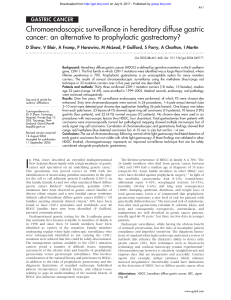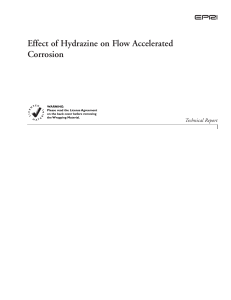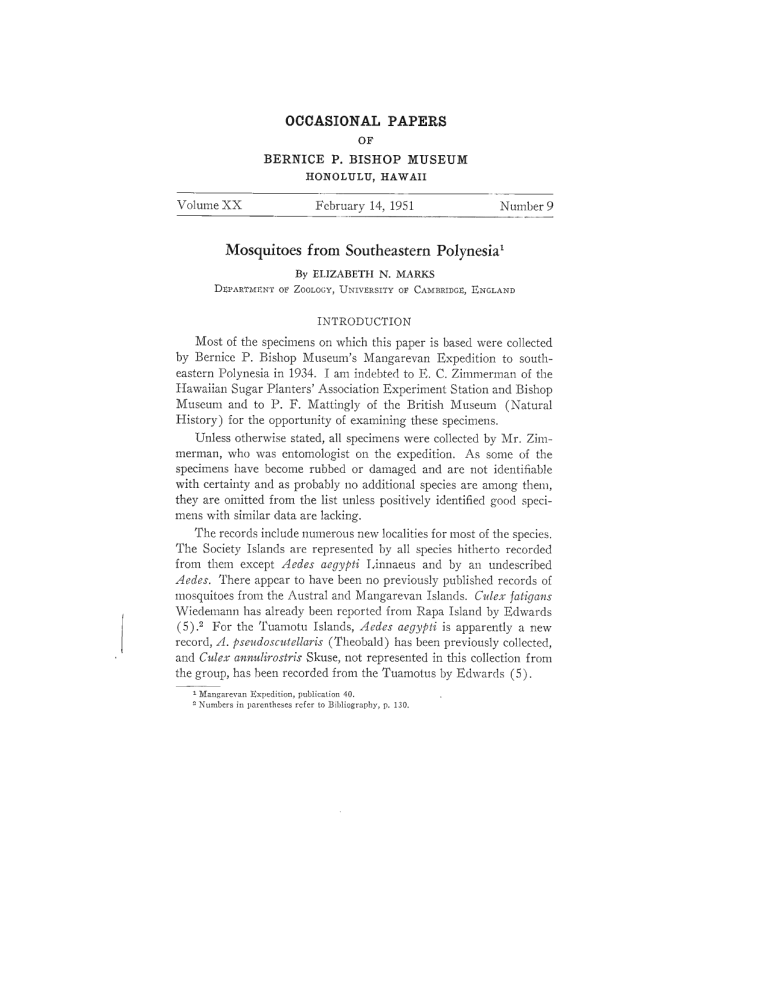
OCCASIONAL PAPERS OF BERNICE P. BISHOP MUSEUM HONOLULU, HAWAII Volume XX February 14, 1951 Number 9 Mosquitoes from Southeastern Polynesia1 By EJJZABETH N. MARKS DEPARTMf.NT OF ZOOLOGY, UNIVERSITY OF CAMBRIDGE, ENGLAND INTRODUCTION Most of the specimens on which this paper is based were collected by Bernice P. Bishop Museum's Mangarevan Expedition to southeastern Polynesia in 1934. I am indebted to E. C. Zimmerman of the Hawaiian Sugar Planters' Association Experiment Station and Bishop Museum and to P. F. Mattingly of the British Museum (Natural History) for the opportunity of examining these specimens. Unless otherwise stated, all specimens were collected by Mr. Zimmerman, who was entomologist on the expedition. As some of the specimens have become rubbed or damaged and are not identifiable with certainty and as probably no additional species are among them, they are omitted from the list unless positively identified good specimens with similar data are lacking. The records include numerous new localities for most of the species. The Society Islands are represented by all species hitherto recorded from them except Aedes aegypti Linnaeus and by an undescribed Aedes. There appear to have been no previously published records of mosquitoes from the Austral and Mangarevan Islands. Culex fatigans Wiedemann has already been reported from Rapa Island by Edwards (5).2 For the Tuamotu Islands, Aedes aegypti is apparently a new record, A. pseudoscutellaris (Theobald) has been previously collected, and Culex annulirostris Skuse, not represented in this collection from the group, has been recorded from the Tuamotus by Edwards (5). Mangarevan Expedition, publication 40. , Numbers in parentheses refer to Bibliograph)', p. 130. 1 124 Bernice P. Bishop Nluseu1"Il-Occasional Papers XX, 9 Specimens of the Aedes scutellaris subgroup, as defined by Knight and Hurlbut (8), in the collection include three groups: (1) specimens definitely identifiable as A. pseudoseutellaris, agreeing with types and topotypical specimens and published descriptions. (2) specimens of both sexes corresponding to the above in all respects, except for the presence of varying amounts of pale scaling on the underside of the proboscis. In some, the pale scaling is definite; but in others it is apparent only in certain lights, so that it is difficult to decide whether the proboscis should be regarded as pale-scaled beneath or not. A comparison shows the male genitalia to be identical with those of typical A. pseudoscutellaris, except in one male from Raivavae which has one slender scale on the basal lobe of one coxite in addition to the usual setae. As other males from the same locality, also with pale scales under the proboscis, show no sign of such a scale, it is not regarded as more than an unusual aberration. At least until further information may be forthcoming, it seems advisable to regard these specimens as A. pseudoscutellaris also. Their occurrence is indicated in the list of localities. (3) damaged specimens which are not identifiable with complete certainty beyond the scutellaris subgroup. No reason has been found to suggest that any forms other than the two preceding are included here. Where these represent additional localities, they are listed uncler Aedes sp. in the scutellaris subgroup. The bulk of this collection will be returned to Bishop Museum, but representative specimens from it will be deposited in the British Museum (Natural History) and University of Queensland collections. Records of mosquitoes from southeastern Polynesia are scattered through the literature. A summary has been made of the known dish-ibution of each species in this area, including data from the present collection. This, together with a simple key to the identification of adults of these species, may serve as a guide to entomologists visiting this area and encourage the collecting of mosquitoes on islands from v..·hich there are no records at present. No attempt has been made to give a complete synonymy, but I have listed the names under which each species has been previously recorded from southeastern Polynesia. The concept of the extent of southeastern Polynesia is that of Zimmerman (11). Maries-Aiosquitoes front Southeastern Po!ynes£a 125 MOSQUITOES OF THE MANGAREVAN EXPEDITION COLLECTION SOCIETY ISLANDS Aedes (Stegomyia) pseudoscutellaris (Theobald). Tahiti: Tiupi Bay, Papeari, 3 females, at light, April 1, 1934; 1 female (with pale scales under proboscis), on tnape (lnocarpus edul£s) , April 2, 1934; 1 female (with pale scales under proboscis), April 6, 1934; 1 female, April 11, 1934. Mataia [Mataiea], 2 females, July 8, 1932, G. P. Wilder, collector. Papeari, 22 females, 23 males (5 females, 7 males with pale scales under proboscis), Nov. 1932, Harrison Smith, collector. Fautaua Gorge, alt. 1,500-2,000 ft., 4 males, March 13, 1934. Near Papeete, 1 female, March 23, 1934. Vairao, Haoma Eiver, alt. 600-700 ft., 1 female, March 30, 1934. Moorea: Urufara Valley, alt. 200-400 ft., 2 females, Sept. 22, 1934. Huahine: Valley west of Mount Turi, alt. 800 ft., 2 males (with pale scales under proboscis), Sept. 30, 1934. Meetia [Mehetia] : Fatia-po, alt. 500-1,000 ft., 3 females, May 12, 1934. Aedes (Stegomyia) species, in scutellaris subgroup. Tahiti: Fautaua Valley, 3 females, March 13, 1934; Papara District, 5 females, clay mosquito, Nov. 26 [year?], G. P. Wilder, collector. Arihiri, Pare, 1 female, March 17, 1934. Afaahiti, near Vaitaare, 1 female, March 20, 1934. These are damaged specimens. Aedes species. Tahiti: Tiupi Bay, Papeari, 1 female, at light, April 1, 1934. This specimen apparently belongs to an undescribed species of subgenus Ochlerotatus or Aed£n1orphus. It has the proboscis pale-scaled beneath in the middle, dark-scaled wings, unbanded abdominal tergites and basal white bands on hind tarsal segments 1-4 (5 missing). As this species may be described soon from a large series obtained by S. A. Edgar of L'Institut de Recherches Medicales, Tahiti, I am not describing it in detail or giving it a name here. Culex (Culex) annu1irostris Skuse. Tahiti: Tiupi Bay, Papeari, 1 female, at light, March 29, 1934; 1 female, onllIape, April 4, 1934; 7 females, 1 male, April 16, 1934. Blue 126 Bernice P. Bishop .lvluseum-Occasional Papers XX) 9 Lagoon, Papeete, 1 female, 1 male, at light [March 4, 1934?]. Near Papeete, 1 female, March 23, 1934. Culex (Culex) fatigans Wiedemann. Tahiti: Tiupi Bay, Papeari, 8 females, 3 males, April 16, 1934; 1 female, at light, March 29, 1934; j females, at light, March 28, 1934; 1 female, at light, April 1, 1934. Papeari, 12 females, 15 males, November 1932, Harrison Smith, collector. Moorea: Opunohu, 1 male, on coconut leaves, Aug. 2, 1932, G. P. Wilder, collector. Culex (Culex) atriceps Edwards. Tahiti: Tiupi Bay, Papeari, 6 females, April 16, 1934. AUSTRAL ISLANDS Aedes (Stegomyia) pseudoscutellaris (Theobald). Rimatara: Anapoto, alt. 25 ft., 6 males (1 male with pale scales under proboscis), Sept. 5, 1934. Rurutu: Bluff south of Moerai, alt. 240 ft., 14 males (3 males with pale scales under proboscis), Aug. 26, 1934. 'I'ubuai: Southwest ridge of Mount Taita, alt. 1,200 ft., 1 female, Aug. 20, 1934. Raivavae: Near Ahuoivi, alt. 5 ft., 2 females, 1 male (1 male with pale scales under proboscis), Aug. 5, 1934. Near Ahuoivi Point, alt. 5 ft., 3 females (1 female with pale scales under proboscis), Aug. 9, 1934. Hotuatua Islet, alt. 0-50 ft., 3 females, 10 males (3 females, 4 males with pale scales under proboscis), Aug. 2, 1934. Culex (Culex) annulirostris Skuse. Rimatara: Oromana Hills, alt. 250 ft., 1 male, sweeping grasses and low herbage, Sept. 4, 1934. RAPA Culex (Culex) fatigans Wiedemann. Rapa: Near Ahurei, 19 females, night flyers, July 30, 1934. TUAMOTU ISLANDS Aedes (Stegomyia) aegypti Linnaeus. Makatea: 3 females, 1 male, Oct. 1932, G. P. Wilder, collector. M ar/;;s-lviosquitoes from Southeastern Polynesia 127 Aedes (Stegomyia) pseudoscutellaris (Theobald). Makatea: 2 females, 4 males, Oct. 1932, G. P. Wilder, collector. Anaa: Tukuhora, 78 females (42 females with pale scales under proboscis), May 13, 1934. Aedes (Stegomyia) species, in scutellaris subgroup. Hao: Boring Bay, 2 females (1 female with pale scales under proboscis), May 18, 1934. These are damaged specimens. MANGAREVA ISLANDS Aedes (Stegomyia) pseudoscutellaris (Theobald). Mangareva: South side of Mount Mokoto, alt. 1,000 ft., 2 females, 3 males (1 female, 1 male with pale scales under proboscis), June 6, 1934. Northeast slope of Mount Duff, alt. 100-500 ft., 2 females, May 23, 1934. Aedes (Stegomyia) species, in scutellaris subgroup. Taravai: Northeast side, 1 female, June 1, 1934. This is a damaged specimen. SUMMARY OF MOSQUITO RECORDS FROM SOUTHEASTERN POLYNESIA Aedes (Stegomyia) aegypti Linnaeus. Aedes (Stegomyia) argenteus (Poiret). Society Islands: Tahiti, Raiatea, Borabora. Tuamotu Islands: Makatea. Cook Islands: Rarotonga. Pitcairn Island. Aedes (Stegomyia) pseudoscutellaris (Theobald). Stegomyia variegatus (Doleschall). Aedes (Stegomyia) variegatus (Doleschall) var. pseudoscutellaris (Theobald) . Stegomyia scutellaris (Walker) var. pseudoscutellaris (Theobald). Stegomyia albopicta (Skuse) of Cheesman, Soc. Etudes Oceaniennes, Bull. 19: 245-247, 1927. Society Islands: Tahiti, Raiatea, Borabora, Moorea, Huahine, Mehetia. Tuamotu Islands: Fakarava, Makatea, Anaa, Hao?, Touau. Mangareva Islands: Mangareva, Taravai? 128 Bernice P. Bishop Museum-Occasional Pape'Ys XX, 9 Marquesas Islands: Hivaoa, Tahuata, Fatuhiva, Mohotani, Nukuhiva, Uahuka, Eiao. Cook Islands: Rarotonga, Aitutaki, Mauke. Austral Islands: Rimatara, Rurutu, Tubuai, Raivavae. Aedes spp. Society Islands: Tahiti (an unclescrilJed species of subgenus Oclzlerotatus or Aedinwrphus). Cook Islands: Rarotonga. Buxton and Hopkins (2) suggest that an undctermined Aedes rccorded by McKenzie (9) from Rarotonga was probably Aedes (Aedimorphus) vexans Meigen. Culex (Culex) annulirostris Skuse. Society Islands: Tahiti, Raiatea. Tuamotu Islands: Fakarava. Austral Islands: Rimatara. Culex (Culex) fatigans Wiedemann. Culex quinquefasciatus Say of American authors. Society Islands: Tahiti, Raiatea, MOOl'ea. Marqucsas Islands: Hivaoa, 'l'ahuata, Fatuhiva, Eiao. Cook Islands: Rarotonga. Rapa. Fanning Island. Manihiki Islands?: Buxton and Hopkins (2) suggest that mosquitoes reported by Gill from Rakaaga [Rakahanga], Penrhyn, and Manihiki were probably C. fatigans. Culex (Culex) atriceps Edwards. Culex nigriceps of Buxton, Soc. f:tudes Oceanicnnes, Rull. 21: 306-308, 1927. Society Islands: Tahiti. Kgy 'f0 ADULTS OF MOSQUITOES R.ECORDED FROM SOUTIlEASTBRN POLY NBslA 1. Hind tarsi with broad white rings 2 Hind tarsi un banded or with very narrow white rings 4 2. Mesollotum with definite pattern of white scales........................... .. 3 Mesonotul11 without definite white pattern; abdominal tergites unbanded (Tahiti) Aedes species. Alar/;;s-Alosquitoes from Southeastern Polynesia 129 3. Mesonotal pattern a single medial tapering white stripe; abdominal tergites with incomplcte subbasal bands (fig. 1, (1, b) _mn__ n__...n mnn __ m n Aedes pseudoscutellaris. Mesonotal pattern resembling a lyre, with broad anterolateral lines and a pair of narrow submedial lines; abdominal tergites basally banded nh_h__ mn.mmm.mmmmn_n_nm_n ... n m_mmnAedes aegypti. (fig. 1, c) 4. Proboscis unbanded; tarsi conco!orOUS......_h_...... nnmmmnh h__ hm 5 Proboscis with medial white band; tarsi with narrow white rings; basal pale bands on at least some abdominal tergites produced to a point medially (fig. 1, d, e)hm __ nmnmn_mm_mmmnmmm_mm __ hCulex annulirostris. 5. Line of broad white scales bordering the eyes; light stripes OR pleural integument; abdominal tergites unbanded (fig. 1, f) Culex atriceps. No broad scales bordering eyes; pleural integument concolorous; abdominal tergites basally banded hm h h ...hhCulex fatigans. _ _ _ _ _ _ 00 00 • __ • a FIGURE I.-a, b, Aedes pseudoscutcllaris: a, mesonotal pattern (from a female from Papeari, Tahiti) ; b, hind tarsus. c, A. ac!!ypti, mesonotal pattern. d, e, Culex annulirostris: d, abdominal tergite, e, hind tarsus. f, C. atriceps, lateral view of thorax showing pale markings of pleural integument. As there is no definite record of Aedes 'l/exal/S from southeastern Polynesia, it is omitted from the key. The tarsal bands are narrower than in Aedes sp. from Tahiti and abdominal tergites are basally banded, but the bands are not produced into points as in Culex annulirostris. It would key out to one of these species in the foregoing key. 130 Bernice P. Bishop Museum-Occasional Papers XX, 9 BIBLIOGRAPHY 1. BUXTON, P. A., Sur les moustiques de Tahiti et du groupe des IIes de la Societe, Soc. Etudes Oceaniennes, Bul!. 21: 306-308, 1927. 2. BUXTON, P. A., AND HOPKINS, G. H. E., Researches in Polynesia and Melanesia, pts. 1-4, London School of Hygiene and Tropical Medicine, 1927. 3. CHEESMAN, L. E., Notice sur les moustiques de Tahiti . . ., Soc. Etudes Oceaniennes, Bul!. 19: 245-247, 1927. 4. EDWARDS, F. W., Mosquito notes, 6, Bul!. Ent. Res. 17: 101-131, 1926. 5. EDWARDS, F. W., Diptera Nematocera from the South Pacific collected by the "St. George" Expedition, 1925, Ann. Mag. Nat. Hist. IX, 20: 236-244, 1927. 6. EDWAIUJS, F. W., Mycetophilidae, Culicidae, and Chironomidae and additional records of Simuliidae, from the Marquesas Islands, B. P. Bishop Mus., Bul!. 114: 85-92, 1933. 7. FARNER, D. S., AND BOHART, R. M., A preliminary revision of the scutellaris group of the genns Aedes, U. S. Navy Med. Bull. 44: 37-53, 1945. 8. KNIGHT, K. L., AND HURLBUT, H. S., The mosquitoes of Ponape Island, eastern Carolines, Washington Acad. Sci., Jour. 39: 20-34, 1949. 9. McKENZIF" A., Observations on filariasis, yaws and intestinal helminthic infections in the Cook Islands with notes on the breeding habits of Stcgomyia pseudosctltellaris, Roy. Soc. Trop. Mce!. and Hygiene, Trans. 19: 138-149, 1925. 10. MUMFORD, E. P., AND ADAMSON, A. M., Entomological researches in Marquesas Islands, Fifth International Congress of Entomology 2: 431-450, 1933. 11. ZIMMERMAN, E. C., Insects of Hawaii, vo!. 1, Honolulu, 1948.

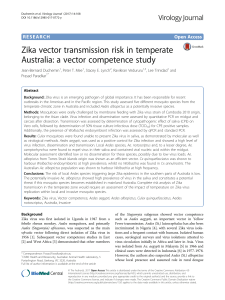
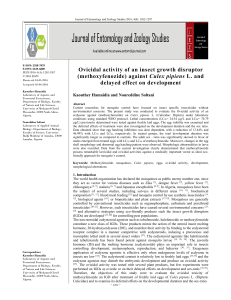
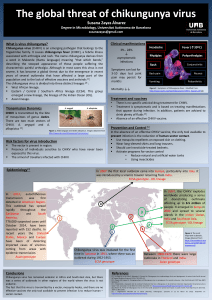
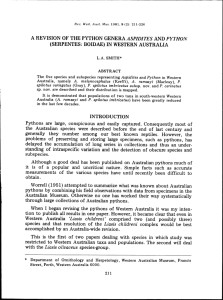
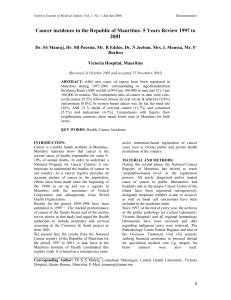

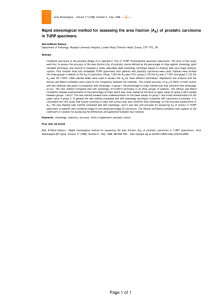
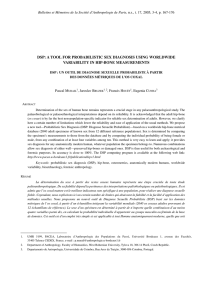
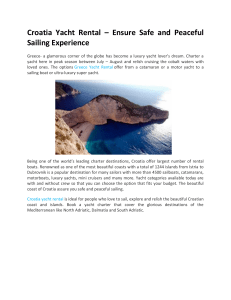
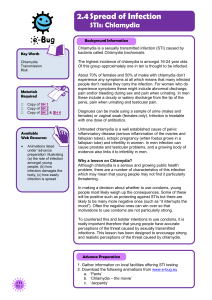
![[arxiv.org]](http://s1.studylibfr.com/store/data/009563307_1-34b369bbe64f1ab70b07309738d2249b-300x300.png)
